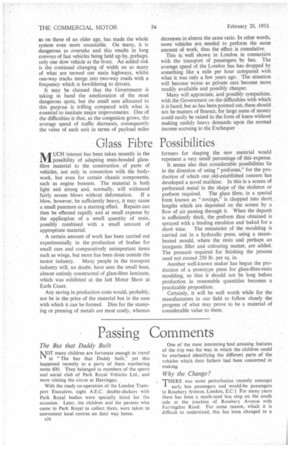Glass Fibre Possibilities
Page 28

If you've noticed an error in this article please click here to report it so we can fix it.
MUCH interest has been taken recently in the possibility of adapting resin-bonded glassfibre material to the construction of parts of vehicles, not only in connection with the bodywork, but even for certain chassis components, such as engine bonnets. The material is both light and strong and, normally, will withstand fairly severe blows without deformation. If a blow, however, be sufficiently heavy, it may cause a small puncture or a starring effect. Repairs can then be effected rapidly and at small expense by the application of a small quantity of resin, possibly combined with a small amount of appropriate material.
A certain amount of work has been carried out experimentally in the production of bodies for small cars and comparatively unimportant items such as wings, but more has been done outside the motor industry. Many people in the transport industry will, no doubt, have seen the small boat, almost entirely constructed of glass-fibre laminate, which was exhibited at the last Motor Show at Earls Court.
Any saving in production costs would, probably, not be in the price of the material but in the ease with which it can be formed. Dies for the stamping or pressing of metals are most costly, whereas formers for shaping the new material would represent a very small percentage of this expense.
It seems also that considerable possibilities lie in the direction of using "preforms," for the production of which one old-established concern has developed a novel =Chine. In this is a screen of perforated metal in the shape of the skeleton or preform required. The glass fibre, in a special form known as " rovings." is chopped into short lengths which are deposited on the screen by a flow of air passing through it. When the deposit is sufficiently thick, the preform thus obtained is sprayed with a binding emulsion and baked for a short time. The remainder of the moulding is carried out in a hydraulic press, using a steamheated mould, where the resin and perhaps an inorganic filler and colouring matter, are added. The pressure required for finishing the process need not exceed 250 lb. per sq. in.
Another well-known maker has begun the production of a prototype press for glass-fibre-resin moulding, so that it should not be long before production in reasonable quantities becomes a practicable proposition.
Certainly, it will be well worth while for the manufacturers in our field to follow closely the progress of what may prove to be a material of considerable value to them.




















































































